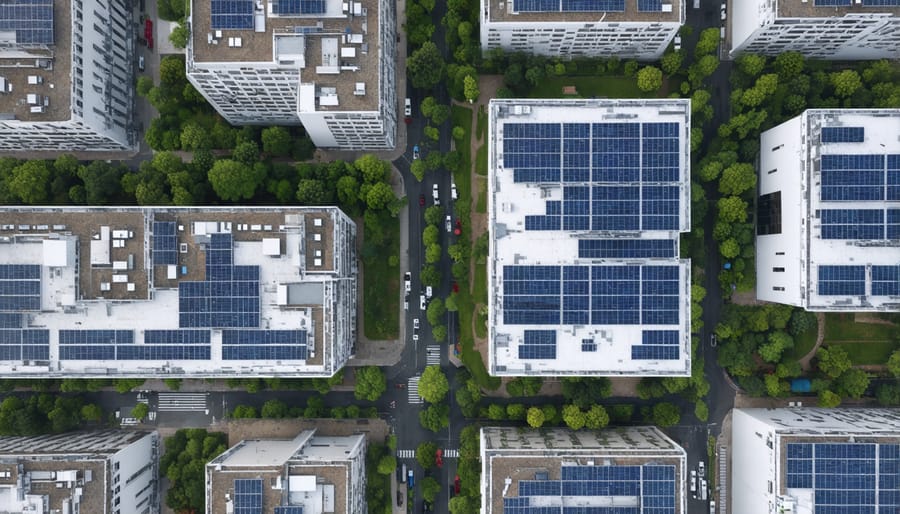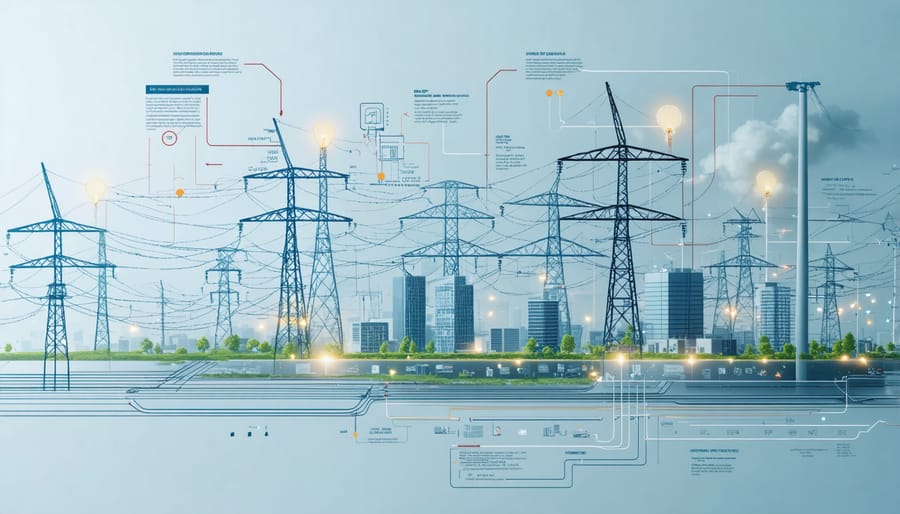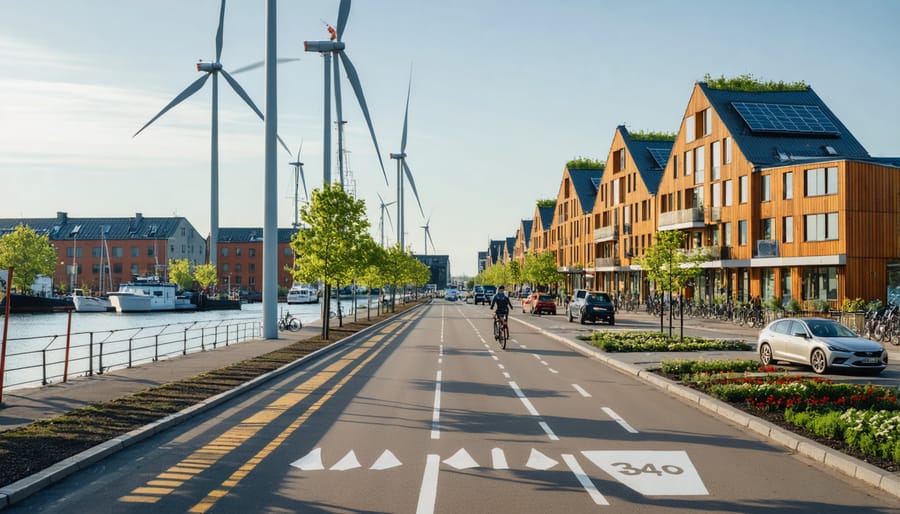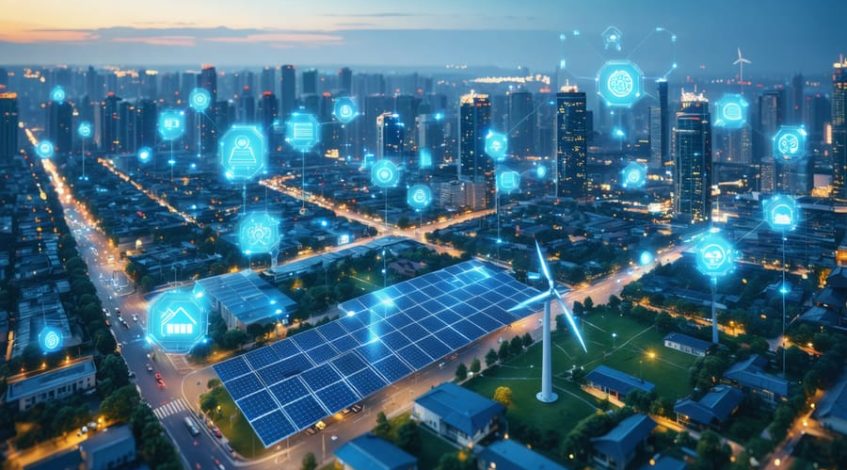Green energy initiatives are transforming the global energy landscape, driving unprecedented opportunities for businesses and municipalities to achieve both environmental and economic objectives. As cities worldwide face mounting pressure to reduce carbon emissions, innovative renewable energy technologies have emerged as cornerstone solutions for sustainable urban development. Recent data from the International Renewable Energy Agency (IRENA) indicates that renewable energy investments yield returns between 3-7 times higher than initial costs, making them increasingly attractive to forward-thinking organizations.
The convergence of falling technology costs, supportive policy frameworks, and urgent climate action requirements has created a pivotal moment for green energy adoption. Leading municipalities have demonstrated that comprehensive renewable energy strategies can reduce operational costs by 25-40% while strengthening grid resilience and energy independence. These initiatives not only address immediate environmental concerns but also position communities and businesses at the forefront of the clean energy transition, creating new economic opportunities and enhancing competitive advantage in an increasingly sustainability-focused market.
The Evolution of Urban Energy Planning
Current Challenges in Urban Energy Systems
Urban energy systems face significant challenges as cities strive to transition toward sustainable infrastructure while meeting growing energy demands. The aging power grid in many metropolitan areas struggles to accommodate increasing electricity consumption, leading to reliability issues and distribution inefficiencies. These legacy systems, designed for one-way power flow, require substantial upgrades to integrate renewable energy sources effectively.
Infrastructure limitations present a particular challenge for renewable energy integration. Many urban buildings lack the necessary electrical systems to support solar installations or energy storage solutions. Additionally, space constraints in densely populated areas restrict the deployment of large-scale renewable energy projects, forcing cities to explore innovative approaches like vertical solar installations and distributed energy resources.
Grid stability remains a critical concern as cities increase their renewable energy capacity. The intermittent nature of solar and wind power requires sophisticated load management systems and enhanced storage capabilities. Urban planners must also address the challenge of peak demand management while ensuring consistent power supply during adverse weather conditions.
Despite these obstacles, cities are developing comprehensive strategies to overcome these limitations through smart grid technologies, energy-efficient building codes, and advanced monitoring systems. These solutions pave the way for more resilient and sustainable urban energy infrastructure.
Emerging Solutions in Green Urban Planning
Modern cities are increasingly adopting innovative approaches to integrate renewable energy into their urban fabric. Smart grid systems now enable dynamic energy distribution across municipal buildings, while solar-powered street lighting and electric vehicle charging stations are becoming standard features in new developments.
Vertical gardens and green roofs serve dual purposes, providing both energy efficiency through natural insulation and opportunities for small-scale urban agriculture. These installations reduce building energy consumption by up to 25% while contributing to biodiversity and improved air quality.
Cities like Copenhagen and Singapore are pioneering the concept of “energy-positive districts,” where neighborhoods generate more renewable energy than they consume. This is achieved through a combination of rooftop solar arrays, wind turbines, and waste-to-energy facilities integrated seamlessly into the urban landscape.
Advanced building codes now mandate energy-efficient design elements and renewable energy integration in new construction projects. These regulations, coupled with incentive programs for retrofitting existing structures, are accelerating the transition toward sustainable urban environments. The implementation of IoT sensors and smart technology enables real-time monitoring and optimization of energy consumption across urban infrastructure.
Key Components of Green Energy Integration

Solar Infrastructure in Urban Spaces
Urban spaces present unique opportunities and challenges for renewable energy adoption, with solar panel integration emerging as a leading solution for sustainable urban development. Modern architectural designs increasingly incorporate photovoltaic systems into building facades, rooftops, and public infrastructure, maximizing previously underutilized spaces for clean energy generation.
Cities worldwide are implementing innovative approaches to solar infrastructure deployment. For instance, the Melbourne City Council’s initiative to outfit municipal buildings with solar arrays has reduced energy costs by 25% while providing a blueprint for other metropolitan areas. Similarly, Singapore’s solar-ready roof requirements for new construction projects demonstrate how policy frameworks can drive sustainable urban development.
Building-integrated photovoltaics (BIPV) represent a significant advancement in urban solar implementation. These systems serve dual purposes: generating electricity while functioning as building materials for walls, windows, or roofing components. The Bank of America Tower in New York exemplifies successful BIPV implementation, incorporating solar panels into its curtain wall design while maintaining aesthetic appeal.
Public spaces are also being transformed through solar innovation. Solar-powered street lighting, parking canopies, and transit stations are becoming commonplace in progressive cities. These installations not only generate clean energy but also provide practical amenities like electric vehicle charging stations and weather protection, demonstrating the multifunctional potential of urban solar infrastructure.
Smart Grid Implementation
The transition to modern grid systems represents a crucial step in optimizing renewable energy integration and distribution. Smart grid implementation combines advanced metering infrastructure (AMI), automated distribution systems, and real-time monitoring capabilities to create a more efficient and responsive energy network.
Key components include smart meters that enable two-way communication between utilities and consumers, sophisticated load management systems, and intelligent automation that can quickly respond to fluctuations in energy demand. These technologies work together to reduce power losses, improve grid reliability, and facilitate the integration of distributed energy resources.
Recent deployments in cities like Copenhagen and Singapore demonstrate how smart grids can achieve up to 15% reduction in energy consumption while improving grid stability. The technology enables dynamic pricing models, allowing businesses and consumers to optimize their energy usage during off-peak hours. Additionally, smart grids provide essential data analytics capabilities, helping utilities predict maintenance needs and prevent outages before they occur.
For facility managers and urban planners, smart grid adoption offers significant returns through reduced operational costs and enhanced energy security.

Energy Storage Solutions
Energy storage solutions play a pivotal role in maximizing the efficiency of renewable energy systems in urban environments. Modern storage technologies bridge the gap between intermittent renewable generation and consistent power demands, ensuring reliable energy supply throughout varying conditions.
Battery energy storage systems (BESS) represent the most widely adopted solution, with lithium-ion technology leading the market. These systems offer scalability and rapid response times, making them ideal for commercial buildings and municipal facilities. Advanced thermal storage systems, including molten salt and phase-change materials, provide alternative solutions for large-scale applications.
Emerging technologies like flow batteries and hydrogen storage systems are gaining traction for their long-duration storage capabilities. Flow batteries, in particular, offer extended operational lifespans and minimal capacity degradation, making them cost-effective for commercial applications.
Smart grid integration enables these storage solutions to participate in demand response programs, generating additional revenue streams through peak shaving and grid services. Organizations implementing storage systems typically see ROI within 5-7 years, with benefits including reduced utility costs, enhanced energy security, and improved power quality.
Recent innovations in energy management systems have further optimized storage deployment, allowing for automated operation based on real-time energy pricing and demand patterns.
Policy Framework and Implementation
Regulatory Standards and Compliance
Compliance with regulatory standards is a crucial aspect of implementing green energy initiatives. In the United States, the Environmental Protection Agency (EPA) and Department of Energy (DOE) establish federal guidelines, while state-specific regulations provide additional frameworks for renewable energy adoption.
Key federal regulations include the Clean Air Act amendments, which incentivize renewable energy deployment, and the Energy Independence and Security Act, which sets efficiency standards and promotes sustainable energy solutions. Organizations must also comply with the Federal Energy Regulatory Commission (FERC) requirements for grid interconnection and energy trading.
State-level Renewable Portfolio Standards (RPS) mandate specific percentages of renewable energy in utility portfolios, varying by jurisdiction. California leads with ambitious targets requiring 100% clean energy by 2045, while other states maintain varying compliance thresholds.
For businesses implementing green energy projects, ISO 50001 certification provides an international framework for energy management systems. The Leadership in Energy and Environmental Design (LEED) certification system offers additional guidelines for sustainable building practices and energy efficiency.
Organizations must also consider local building codes, zoning regulations, and utility interconnection requirements. Regular audits and reporting are typically required to demonstrate compliance and maintain certifications. Staying current with evolving regulations is essential, as standards frequently update to reflect technological advances and environmental priorities.
Understanding and adhering to these regulatory frameworks not only ensures legal compliance but also positions organizations to benefit from various incentives and tax benefits associated with green energy adoption.
Incentives and Support Programs
Governments and organizations worldwide have established comprehensive renewable energy incentives to accelerate the adoption of sustainable energy solutions. These programs typically include tax credits, grants, and performance-based incentives that significantly reduce initial investment costs and improve long-term returns.
The Federal Investment Tax Credit (ITC) remains one of the most impactful incentives in the United States, offering up to 30% tax credit for solar installations through 2032. Additionally, many states provide complementary programs such as Solar Renewable Energy Certificates (SRECs), property tax exemptions, and net metering policies that enable businesses to monetize their excess energy production.
Commercial entities can benefit from accelerated depreciation through the Modified Accelerated Cost Recovery System (MACRS), allowing them to recover their renewable energy investments more quickly. Local utilities often provide additional support through rebate programs and performance-based incentives that reward efficient energy production.
For public sector initiatives, organizations can access specialized funding through programs like the Energy Efficiency and Conservation Block Grant (EECBG) and various state-level clean energy funds. These resources often combine financial support with technical assistance, helping organizations navigate the complex landscape of renewable energy implementation.
Industry leaders should regularly consult with energy consultants and financial advisors to optimize their incentive strategy, as programs and requirements frequently evolve to meet changing market conditions and policy objectives.
Success Stories and Case Studies
European Urban Renewal Projects
Several European cities have emerged as pioneers in urban renewable energy implementation, demonstrating remarkable success in integrating green energy solutions into existing infrastructure. Copenhagen stands as a prime example, with its comprehensive district heating system powered by biomass and waste-to-energy facilities, serving 98% of households while reducing carbon emissions by 40% since 2005.
In Barcelona, the Solar Thermal Ordinance has transformed the city’s energy landscape by mandating solar water heating systems in new buildings and major renovations. This initiative has led to over 90,000 square meters of solar collectors, generating approximately 70,000 MWh of clean energy annually.
Amsterdam’s Smart City initiative showcases innovative approaches to urban sustainability, featuring smart grid technology and community-owned solar projects. The city’s sustainable neighborhood retrofit program has successfully upgraded over 10,000 homes with energy-efficient systems and renewable energy installations.
Hamburg’s HafenCity project demonstrates how brownfield redevelopment can incorporate renewable energy systems. The district utilizes a combination of solar, wind, and geothermal energy, achieving nearly zero-emission status while revitalizing former industrial areas.
These successful implementations have not only reduced carbon emissions but also created significant cost savings for municipalities and residents. Cities report average energy cost reductions of 25-30% after implementing these renewable solutions, while simultaneously improving grid reliability and creating local green jobs.

Economic and Environmental Impact Analysis
Recent analyses of implemented green energy initiatives demonstrate significant economic and environmental returns across multiple sectors. Studies from 2023 show that commercial solar installations achieve an average ROI of 15-20% within the first five years, with payback periods shortening as technology costs continue to decline.
Organizations implementing comprehensive green energy programs report average utility cost reductions of 30-40% annually. A notable example is the Madison Business Center, which saved $2.1 million in energy costs over three years while reducing its carbon footprint by 12,000 metric tons.
Environmental impact assessments reveal that every megawatt of installed solar capacity prevents approximately 1,200 tons of CO2 emissions annually. Wind energy projects show similar benefits, with a single industrial turbine offsetting roughly 2,600 tons of CO2 yearly.
The job creation impact has been equally impressive, with the renewable energy sector generating 11.5 million jobs globally. Local communities benefit from increased tax revenue, with large-scale installations contributing an average of $700,000 annually per project in property taxes.
Additional benefits include enhanced grid resilience, reduced dependency on fossil fuels, and improved air quality in urban areas. Companies implementing green initiatives report improved stakeholder relations and stronger ESG performance, leading to better access to capital and increased market valuation.
The integration of green energy initiatives into urban planning represents a critical turning point in our approach to sustainable development. As demonstrated throughout this analysis, successful implementation requires a carefully orchestrated balance of policy frameworks, technological innovation, and stakeholder collaboration. Cities worldwide are increasingly recognizing the multiple benefits of incorporating renewable energy solutions, from reduced operational costs to enhanced environmental resilience.
Looking ahead, the trajectory for green energy in urban environments appears promising, with emerging technologies and declining implementation costs making sustainable solutions more accessible than ever. Smart grid systems, advanced energy storage solutions, and improved solar efficiency are set to revolutionize how cities generate and consume power. The growing adoption of building-integrated photovoltaics and district heating systems suggests a future where renewable energy infrastructure becomes seamlessly woven into urban fabric.
However, success will depend on continued commitment from both public and private sectors. Forward-thinking policies, innovative financing mechanisms, and public-private partnerships will be essential to overcome remaining challenges. As more cities demonstrate the feasibility and benefits of comprehensive green energy strategies, we can expect accelerated adoption across global urban centers.
The transition to renewable energy in urban settings is no longer simply an environmental imperative – it has become a compelling economic and social opportunity. By embracing these initiatives today, cities position themselves for sustainable growth, enhanced resilience, and improved quality of life for their residents.

